Five Critical Steps to Thriving Within Your Longevity Bonus
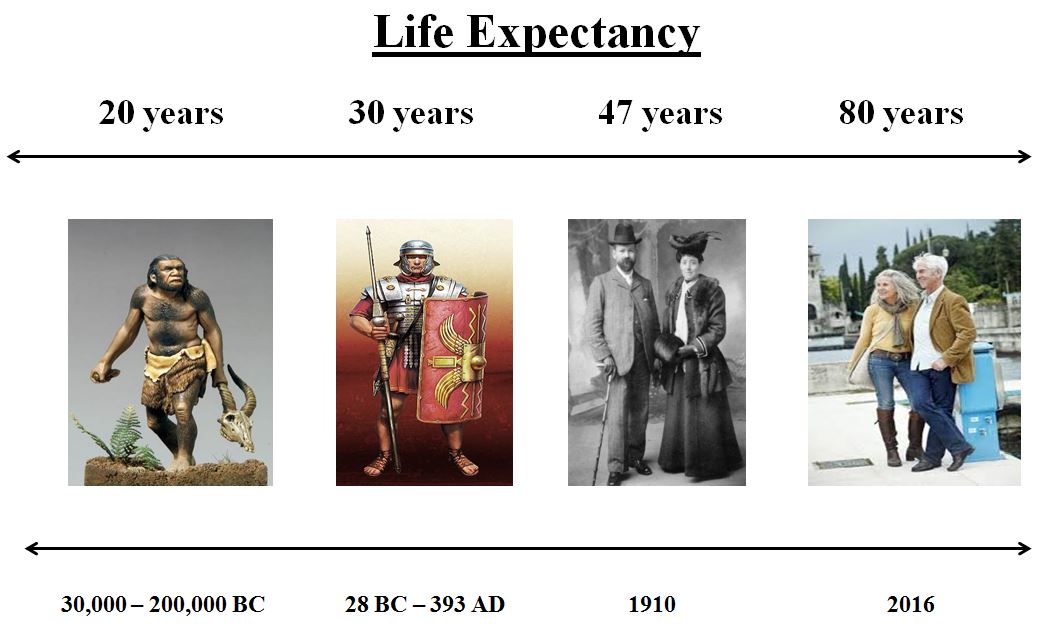
You’ve heard it a thousand times.
We’re living longer. Yay!
We extended our average lifespan more in 110 years than we did in the previous 100,000 years. That’s quite a hockey-stick performance.
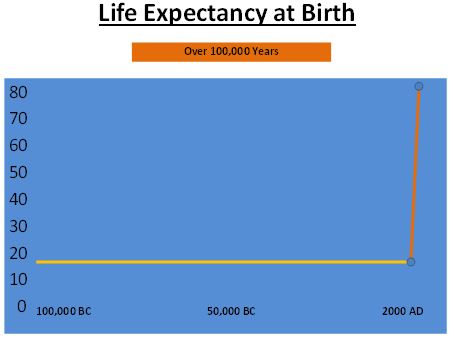
Makes you wonder why we waited so long. What was so magic about the 20th century? I guess you could say that a few folks woke up and started picking low-hanging fruit that was killing us early, and let it accelerate from there.
Like:
- Washing hands before surgery. DUH!
- Better sanitation.
- Finding cures for most of the infectious diseases that dominated the early part of the century.
- Improving education – availability, methods, and content.
- Better food – quality and distribution.
- Cleaner water.
- Safer work environments and implements.
Medicine and technology teamed up and hockey-sticked it for us.
Then we hit a wall. It turns out that the progress stopped – and that longer doesn’t always mean better. The average lifespan in the U.S. has turned down each year since 2016.
It’s self-inflicted!
There’s only so much that medical science can do to maintain the acceleration. The fruit is now high in the tree and hard to get to.
We know that longer isn’t always better because Americans spend an average of ten years in ill-health, more than any other developed country. That’s a long time to feel bad – and it’s incredibly expensive.
It appears that it can only get worse as our population continues to shift to a higher concentration of over-65:
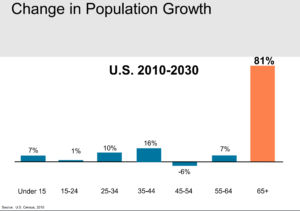
Source: AgeWave
As I wrote about last week, many of us get to the back-nine of life having double- or triple-bogeyed the front-nine with our marginal lifestyle habits and facing an accelerating downward slope that results in “living too short and dying too long.”
What’s the lifespan downturn telling us?
Could it be that we don’t give a darn about this gift of potential healthy longevity brought on by research, science, medicine?
Do we still buy the 20th-century myths, models, and messages about automatic senescence, fate versus choice, genetics versus habits?
Maybe. Probably.
But the scoreboard doesn’t lie. We still seem to choose not to flatten the back-nine slope and live longer in health and shorter in chronicity. Rather, we seem to be given to waiting and hoping for government, science, big pharma to find more miracle life-extenders when the best life-extenders have been around forever and are free.
But inconvenient. And sometimes uncomfortable.
Here are five things to consider while you wait for the next scientific/pharma miracle.
You’ll feel and look better while you wait. Oh, and BTW, you might save yourself and our society a lot of money.
- Adopt WFPB instead of CRAP. Yes, my needle is stuck on the record – and you’re tired of hearing it. The Standard American Diet (SAD) is killing us slowly – and now, more and more of the world.
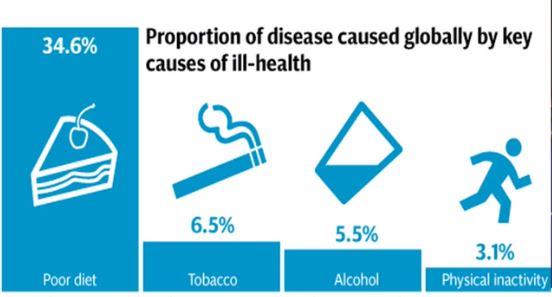 It’s simple in concept, tough in practice. But we know moving to a Whole-Food-Plant-Based diet and away from Calorie-Rich-and-Processed will slow the slope.
It’s simple in concept, tough in practice. But we know moving to a Whole-Food-Plant-Based diet and away from Calorie-Rich-and-Processed will slow the slope. - Cancel Netflix. Or Hulu. Or Prime. Or whatever may have you, along with the average “down-sloper/retiree”, watching 49 hours of TV a week. Divert 15% of the 49 hours to getting your heart rate up and your muscles stronger. That’s only an hour a day of slope-flattening activity.

- Get connected – and care. Don’t be a hermit.

Here’s an untold secret of longevity. Mary Zaraska spells it out in her powerful new book “Growing Young: How Friendship, Optimism, and Kindness Can Help You Live to 100.” (paid link). It’s called having a strong network of family and friends as we age.
Zaraska states that what she learned through research and personal experience is:
” – building a strong support network of family and friends lowers mortality risk by about 45 percent. Exercise, on the other hand, can lower that risk by 23 to 33 percent. Eating six servings of fruit and veg per day can cut the danger of dying early by 26 percent while following the Mediterranean diet by 21 percent. For volunteering, it’s 22 to 44 percent.”
We already know that social isolation is a significant killer, equivalent to smoking 15 cigarettes a day, according to AARP.
- Renew your library card.

Did you know that 40% of college grads never open another book after graduation? It seems still too many of us have decided that those first 20 years of learning were enough, failing to acknowledge that our brains are like a muscle that we’ll lose if we don’t use.
Research is making a direct connection between continued learning and dementia. Curiosity is important for mental health. We’re fully capable of high levels of creativity during the “retirement” years. Never stop learning. Stretch your brain.
- Unretire. It’s happening a lot. Many who bought the “full-stop retirement” Koolaid are experiencing the downsides and altering their retirement lives back to something more than relaxation and rest. Leisure-based, self-indulgent retirement has exposed itself as detrimental to long-term physical and mental health – a definite “slope accelerator.”
Simple, but not easy. The jury has returned with a verdict that our lifestyles are guilty for the deep slope and the big pile at the bottom of the hill. For us “back-niners” it’s a choice between a fence at the top of the slope or an ambulance at the bottom of the hill. We can wait for government, science, or big pharma to build a fence or we can be knowledgeable about our biology, team with our doc, and take charge.
And then that curve just might start turning back up.
Thanks for being a reader. Please scroll down and leave a comment below.

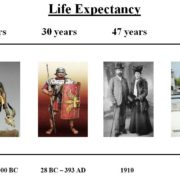



Some people think it’s hard to do all these things during lockdown. But I think it’s the perfect opportunity to experiment with trying out new things and changing your habits. We can contact all our friends and family by writing to them and zooming in on them. We have the time to read loads of books. There’s so many great things you can learn about on the internet – MOOCs for instance are courses from top universities and many of them are free, so it needn’t be expensive. Time for everyone to get going.
You make outstanding points, Rosemary. Thanks for chiming in with these solid suggestions. My wife and I doing some of those things and aren’t feeling as restricted as most but could be doing more, especially reaching out to friends. I have taken advantage of this time to add a couple of professional certifications (Resume writer certification and LinkedIn strategist certification) and have my eyes on a few others plus doing another career pivot to put more emphasis on helping post-50 folks make meaningful, purposeful lifestyle decisions going forward. Thanks for being a reader and for your comment.
Another great article Gary. People need to wake up to what is really happening and how they can better prepare themselves for what lies ahead.
Thanks Mike. I appreciate your comment as one who is “in the trenches” thinking and saying the same things. Looking forward to your next book. Let me know when it’s available.
I work with many clients over 75 and there are common traits for the ones that have a better life. You touched on most of them. The only addition is live with purpose. Every one of my clients 85+ live a life of purpose. It is fun watching people that age start a farm, business, or non-profit. At 60 it gives me hope.
Great point, Butch. I appreciate the perspective you’ve gained as you’ve made this huge life transition and chose to help people in a deep way. The sense of meaning (the “why”) and purpose (the “what’s next”) is sorely lacking in so many of our 60+ peer group as you’ve witnessed. But you “can’t push a rope” – people are going to do what they want. The best we can do is be the example and continue to encourage. Thanks for your insight.
Wonderful article, Gary. Almost everything we need to improve the quality of our lives for longer is already available to us and most of it is free. But changing habits is very tough for most people unless they are able to visualize their healthier, more energetic future self.
Thanks, Eric. Maybe because it is “free” and so obvious, we end up not trusting it as the truth. Your point about visualization is SO important. If you can’t/don’t envision it, there’s no incentive. My vision of something other than wheelchairs, walkers, nurses, needles, and oxygen bottles motivates me. I’ve witnessed too much of that.
Great insights! We knew it, but don’t it! Need to find some hard solution to break it and adopt the habits mentioned. You may throw some ways to do it without compromising.
You are right – we know but don’t do it. Trying to do all of them at once would be difficult. Pick one and grow into it by committing to adopting the habit for 60 days. By then, you’ve replaced the old “bad” habit
I like this website because so much utile material on here : D.
Hello makeagingwork.com webmaster, Your posts are always well-supported by facts and figures.
To the makeagingwork.com webmaster, Great content!
Hi makeagingwork.com administrator, Great content!
Hi! Someone in my Facebook group shared this website with us so I came to give it a look. I’m definitely loving the information. I’m book-marking and will be tweeting this to my followers! Great blog and fantastic design and style.
Hi makeagingwork.com owner, Your posts are always well-supported by facts and figures.
Hi makeagingwork.com admin, Your posts are always well-referenced and credible.
Hi makeagingwork.com admin, You always provide clear explanations and step-by-step instructions.
Dear makeagingwork.com admin, Your posts are always informative and up-to-date.
Dear makeagingwork.com owner, Thanks for the well-researched and well-written post!
To the makeagingwork.com admin, Thanks for the well-researched post!
To the makeagingwork.com owner, You always provide valuable information.
Hello makeagingwork.com webmaster, Thanks for the well-structured and well-presented post!
To the makeagingwork.com owner, Your posts are always well structured and easy to follow.